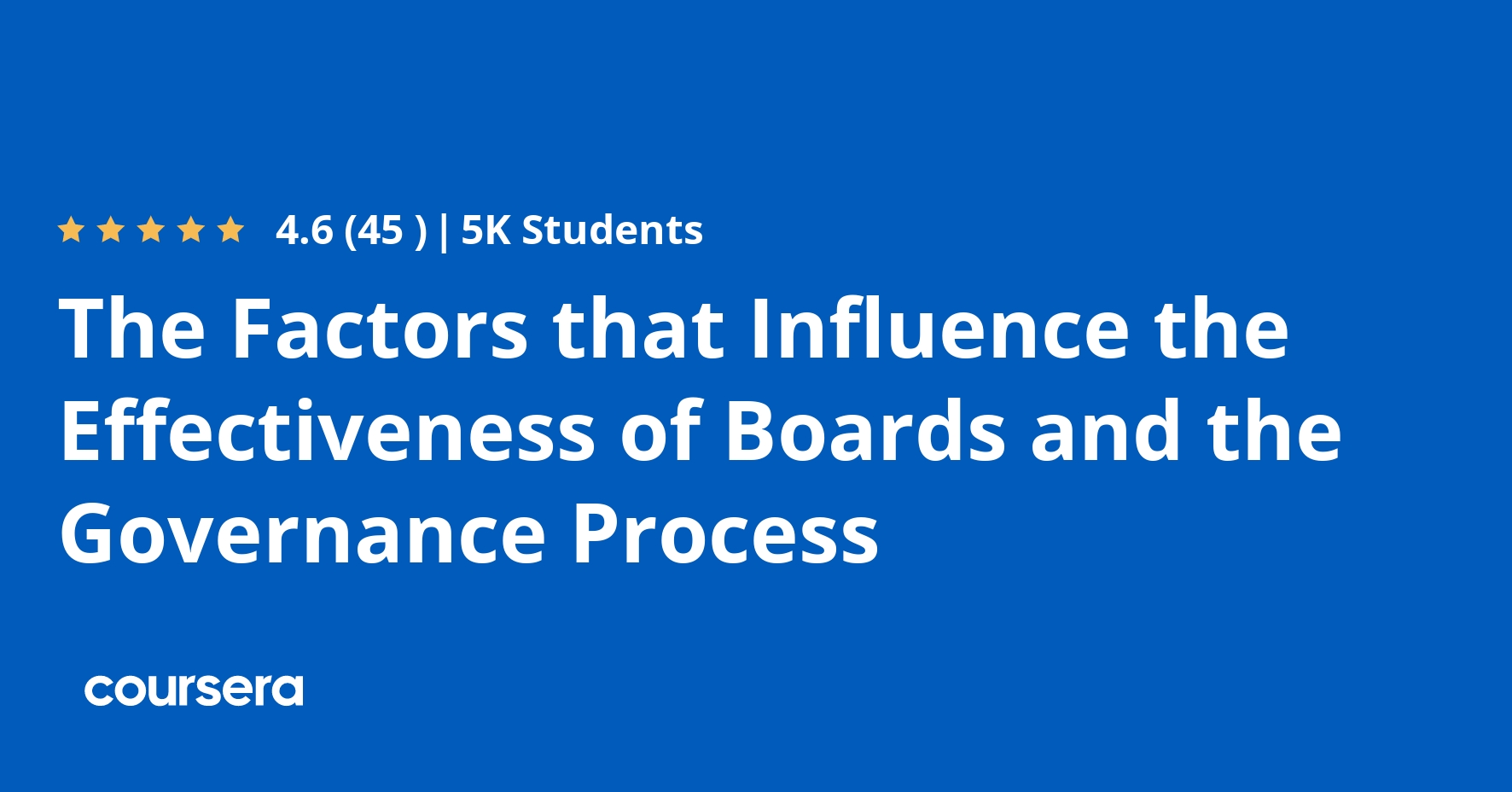Description
The third course in this Specialization introduces you to the factors that influence how effective boards of directors will be in carrying out their roles and responsibilities and hence the impact they have in shaping the success of the organization they govern. While this course has been developed with North American culture in mind, we do appreciate that, in other parts of the world, the nature of the factors that influence the effectiveness of nonprofit boards of directors may vary. Nevertheless,it is our hope that much of the course content will still be of value to those in other parts of the world.
To learn more about this course, please watch the overview video by copying and pasting the following link into your web browser: https://goo.gl/aAMIfl.
Keywords: Nonprofit; Nonprofit Sector; Voluntary Sector; Nonprofit Organizations, Non-Governmental Organizations, Volunteer Organizations, Leadership, Management, Governance, Board, Board of Directors, Performance, Effectiveness
Course 3 Overview:
Week 1: This week’s questions: What factors influence the effectiveness of board meetings? What are the formal procedures and structures within the board that impact its performance? What can a board do to intentionally improve the way it structures itself and runs its decision making meetings?
Week 2: This week’s questions: What do we mean by board composition and development and why is it important? Why is it difficult to change the composition of the board? How do you design the ideal mix of board members? How do you locate, recruit and develop board members?
Week 3: This week’s questions: What do we mean by the “culture” of the board and why is it important? How do boards develop and pass along culture? Can board cultures be intentionally changed? What is the role of leadership in shaping board culture? What do effective nonprofit leaders involved in governance do? How can leadership be managed for higher performance?
Week 4: At this stage, you are asked to review the course content, submit a written assignment (known lightheartedly as a BEAR (Board Effectiveness Readiness Assessment), and take two multiple choice Readiness Assurance Tests (known similarly as RATs). One RAT will assess knowledge and reading comprehension and the other will test application of knowledge within a practical case.
Week 5: We will encourage you to discuss the RATs in the discussion forums and take them again should you wish to change any of your answers based on the information exchanged.
What you will learn
Board Operating Procedures, Structures, and Meetings
Hello and welcome to Course 3 in the series of courses on Improving Leadership and Governance in Nonprofit Organizations! The focus of this course is on the often unrecognized influences on how well a board carries out its governance role and responsibilities. The goal of the first week is to address several important questions related to two key influences on board behavior: the board’s operating procedures and structures and board meetings. Some of the key questions we will explore this week are: What factors influence the effectiveness of nonprofit boards of directors? What are board procedures and structures and why are they important? What issues challenge the effectiveness of board meetings? What can be done to increase governance effectiveness? These questions form the basis of the video lecture and content in Chapters 6 and 7 of our SUNY Open Textbook, Guidelines for Improving the Effectiveness of Boards of Directors of Nonprofit Organizations. We look forward to helping you learn more about some of the factors that influence leadership and governance effectiveness this week!
The Composition and Development of the Board
Hello and welcome to Week 2 of the third course on Improving Leadership and Governance in Nonprofit Organizations! The focus this week is on one of the most difficult challenges to board performance–creating the ideal mix of board members and training them so that they can be as effective as possible. Some of the key questions we will explore this week are: What do we mean by board composition and development and why is it important? Why is it difficult to change the composition of the board? How do you design the ideal mix of board members? How do you locate and recruit the best new board members? What are the best ways to orient and develop board members? Is your board socially and functionally inclusive? These two influences form the basis of the video lecture, special guest interview, and content in Chapter 8 of the SUNY Open Textbook, Guidelines for Improving the Effectiveness of Boards of Directors of Nonprofit Organizations. We look forward to helping you learn about another factor that may influence the leadership and governance of nonprofit organizations this week!
Board Culture and Leadership
Hello and welcome to Week 3 of the third course on Improving Leadership and Governance in Nonprofit Organizations! The goal of this week is to address important questions related to two influences that empirical research suggests are difficult to change in boards of nonprofit organizations—the informal culture and leadership of the board (Harrison and Murray, 2014). Some of the key questions we will explore this week are: What is “culture” and why is it important? What shapes board cultures and can you intentionally change them? What is leadership in the organizational and governance context? What do effective leaders involved in nonprofit governance do? Why are some leaders ineffective? How can leadership be managed for effectiveness? These two influences form the basis of the video lecture and content in Chapter 9 and 10 of the SUNY Open Textbook, Guidelines for Improving the Effectiveness of Boards of Directors of Nonprofit Organizations. We look forward to helping you learn about two more factors that may influence the leadership and governance of nonprofit organizations this week!
Individual Concept Testing and Application
Hello and welcome to Week 4! The goal of this week is to assess course learning. The end of Course 3 assessment of learning begins with the requirement that you to take two Readiness Assurance Tests (RATs) and submit your Board Effectiveness Assessment Reflection (BEAR). During the testing process, don’t forget to make a note of your answers to the RAT and RAT Application Exercise questions. You will need them to vote and discuss your responses in the RAT forums next week.





